|
 |
|
| Part 1 Preparation, Fukuoka Airport to Beppu Spa |
| Part 2 Yufuin, Takachiho Gorge, Aso Kusasenri |
| Part 3 Yanagawa, Oura Church, Glover Garden |
| Part 4 Dazaifu Shrine, This and That |
|
|
|
Part 3
Yanagawa, Oura Church, Glover Garden |
|
December 25th, the 3rd day.
We left Aso Villa Park Hotel near Mount Kuro-dake at 7:30 and enjoyed "Punting
on Yanagawa" for 45 minutes nearly from 10:00. |
|
|
Punting on Yanagawa
(Yanagawa Funakudari)
Divided into 10 people each, we got on a small and narrow boat called "donko-bune",
and sat down symmetrically, not making the boat leaned. It was warm under
the long table because of "kotatsu" (a heating device) there.
The boatman with a rod at the stern gave us a punt tour of the waterway
in Yanagawa raminated across the city like a mesh, mainly around the old
castle's moat. The total time was 45 minutes.
The origin of the waterway is roughly as follows.
Around 2000 years ago, a vast tideland of the Sea of Ariake turned into land, and people dug ditches in the wetland to store domestic and agricultural water.
In the 7th and the 8th centuries a waterway and a grid of paths between rice fields were developed, and a modern castle town emerged. |
The views along the moat were elegant, with weeping willows on both sides.
Especially shaddocks in a row of houses were unforgettable.
It was a bit thrilling to go through under low bridges and covering branches.
The wide and narrow waterways' network is said to span a total length of
about 470 km forming a unique landscape of the water district called "Suigo".
The boatman says, "This atmospheric beauty inspired a great poet Kitahara Hakushu born and raised in Yanagawa, and the landscape has been adored by many later writers and artists following Hakushu."
This precious historic heritage was formed in the course of people living together with water. Preventing inland flood by temporarily storing rain water during stormy seasons and supplying water for agricultural use or in case of fire fighting, the waterways are deeply connected to people's daily life in Yanagawa to this day.
|
|
Our sightseeing in Yanagawa town was only a punt tour.
After one hour stay there, we left for Nagasaki City across the Saga Plain.
Nagasaki City
We are going to visit Oura Catholic Church and Glover Garden here limiting
only in the area of Minami-yamate. The guide says this area is exotic with
European flavor and the China Town.
Though it is over 1:00 p.m., sightseeing is put before lunch.
We entered "The Former Hong Kong and Shanghai Bank Nagasaki Branch
Museum" next to the parking lot.
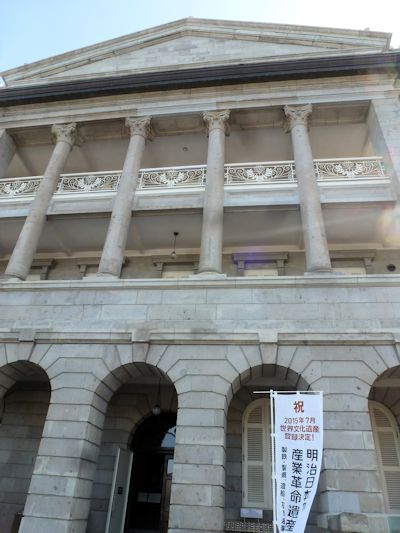
According to the pamphlet of the museum,
The Hong Kong and Shanghai Banking Company established its Nagasaki Branch in 1896. The present building was designed by Kikutaro Shimoda and completed in 1904 as the new office building of the Nagasaki Branch. After the closure of the Nagasaki Branch in 1931, the building was utilized for other purposes, becoming a police station and later a museum.
Upon request from the citizens of Nagasaki, the building underwent restoration
work and reopened in 1996 as the Former Hong Kong and Shanghai Bank Nagasaki
Branch Museum. Following renovations, the museum reopened in April 2014
as a facility incorporating the Nagasaki Museum of Modern-Era Exchange. |
Our couple went up to the 3rd floor and looked around with the tour members.
I am sorry I did not have special impression.
Then free time to everybody until 4:30 p.m.
Instead of going to China Town, we hit the chao nearby at the "wakaran-style"
restaurant "Shikairo".

"WA-KA-RAN" means the dish with Japanese (WA), Chinese (KA) and
Dutch (RAN) coexisting.
Shikairo was so crowded that we had to wait for 30 minutes.
We ordered champon and soboro-sara-udon of the restaurant's pride, and
shared them, nodding and saying, "This is the taste of Nagasaki".
Soboro-sara-udon was superb and eaten out firstly.
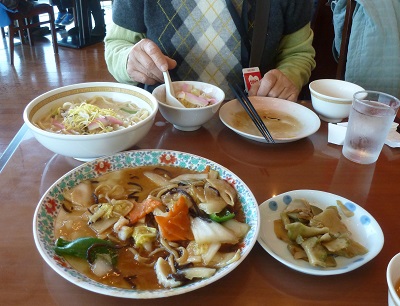
|
|
| Oura Catholic Church
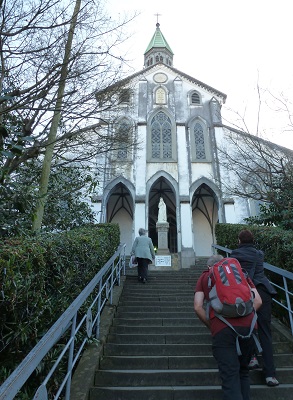
I have to ask for help to Wikipedia here, too.
| Oura Church is a Roman Catholic church in Nagasaki, built soon after the end of the Japanese government's Seclusion Policy in 1853. It is also known as the Church of the 26 Japanese Martyrs. It was for many years the only Western-style building declared a national treasure, and is said to be the oldest church in Japan. |
We entered it and looked around based on the above understanding, but its
inside seemed plain and small-scale compared with the cathedrals in Europe.
Therefore or not, I could not feel the deep flavor inside, admitting my inexperience.
No photograph in the church.
Wikipedia explains how its construction was realized as follows. Just for
the reference of myself.
| In 1863, two French priests from the Sociéte des Missions Étrangères, Fathers
Louis Furet and Bernard Petitjean, landed in Nagasaki with the intention
of building a church honoring the Twenty-Six Martyrs of Japan, nine European
priests and seventeen Japanese Christians who were crucified in 1597 by
order of Toyotomi Hideyoshi. The church was finished in 1864. Constructed
by the master carpenter of the Glover Residence, Koyama Hidenoshin, it
was originally a small wooden church with three aisles and three octagonal
towers. The present structure is a much larger Gothic basilica that dates from
around 1879. This version was built of white stuccoed brick with five aisles,
vaulted ceilings, and one octagonal tower. The design most likely came
from a Belgian plan used by Catholic missionaries in an earlier church
built in Osaka. The stained glass windows were imported from France. |
|
|
| Glover Garden
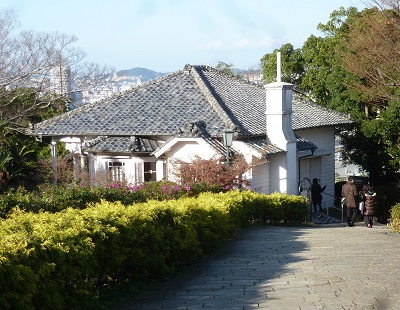
Glover Garden was just near Oura Catholic Church.
It is located on a hill. The slope is steep and long. So, the escalator
was really helpful. I thanked it, feeling suspicious about whether it was
here when I visited last time in 2000.
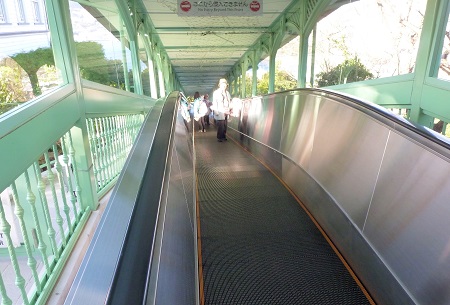
 Glover Garden is a park built for Thomas Blake Glover, a Scottish merchant
who contributed to the modernization of Japan in shipbuilding, coal mining,
and other fields. In it stands the Glover Residence, the oldest Western
style house surviving in Japan and Nagasaki's foremost tourist attraction. Glover Garden is a park built for Thomas Blake Glover, a Scottish merchant
who contributed to the modernization of Japan in shipbuilding, coal mining,
and other fields. In it stands the Glover Residence, the oldest Western
style house surviving in Japan and Nagasaki's foremost tourist attraction.
It is located on the Minami-yamate hillside overlooking Nagasaki harbor.
It was built by Koyama Hidenoshin and completed in 1863.
The plan for the house, which is still preserved, is unsigned. It is interesting to note that the plan uses "feet" instead of Japanese measurements. The basic construction of the house is Japanese, despite its foreign elements. It consists of traditional Japanese roof supports and post-and-beam frames set down on boulders.
It has been designated as an Important Cultural Asset.
As the house and its surroundings are reminiscent of Puccini's opera, it
is also known as the "Madame Butterfly House." Statues of Puccini
and diva Miura Tamaki, famed for her role as Cio-Cio-san (蝶々さん), stand
in the park near the house.
This house was also the venue of Glover's meetings with rebel samurai particularly
from the Choshu and Satsuma domains.
The Glover Residence is noted for its blend of Western and Japanese elements
and is an example of treaty port building. This type of architecture closely
resembles one-story bungalows used by foreigners in Hong Kong or Shanghai
and imported to Japan by British traders. Rather than following contemporary
Victorian styles, this type of building more closely reflects the Georgian
aesthetic popular in Britain during the previous generation.
The stone-floored verandas, latticed arches, and French windows are several of the distinctive foreign elements included in the residence, while Japanese influence can be seen in the tile roof with its demon-headed tiles intended to ward off evil. The roof was modified by adding unmistakably British chimneys.
The park also includes Ringer House (built in 1865 for Frederick Ringer)
and Alt House (built for William Alt). The correct treatment of the Tuscan
pillars and pediment at the Alt House suggest that this building was designed
by a Western architect. The pediment is often conspicuously incorporated
into Masonic temples, and might have been employed here in the same manner
as a Masonic symbol.
-----
To be honest, I have a previous memory in 2000 of only Old Glover House
here.
This time, as Old Mitsubishi 2nd Dock house on the hilltop at the starting
point, we saw the sights of various houses of European style, like Ringer,
Alt, ....., while going down the slope.
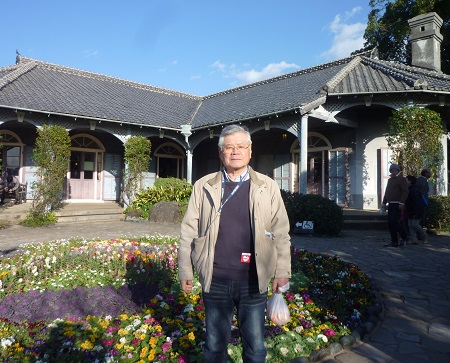
-----
Just as we were leaving, we found the hall of Nagasaki traditional performing
art and entered it.
Many performances of "Nagasaki Okunchi" were displayed all around
the hall.

This is just for my reference, too, by the help of Wikipedia.
Nagasaki Okunchi is the most famous festival in Nagasaki. It began as a celebration of
autumn harvests in the late 16th century and became a shrine festival when
Suwa Shrine was founded in 1642.
One of the most famous performances of the festival is the Dragon Dance
which was originally performed on New Year's Eve by the Chinese residents
of Nagasaki. Rehearsals for the festival begin on June 1. During October
7-9 the presentations of the festival, which vividly reflect Nagasaki's
colourful history, spill over from the three festival sites into the streets
and create an atmosphere of celebration throughout the city. |
|
|
By the way, I got a deep impression that Nagasaki is the town of slopes,
not only this time during visiting Glover Garden but also in the experience
here 15 years ago in 2000.
As there are so many houses up and among the hills here, Nagasaki has the
view of a different culture and famous for its million dollar night view
in the world.
The slopes are said to have been terraced fields until Edo Period.
During late Edo Period and early Meiji Period, the houses of foreign people
were built from the hilltop matched with the terraced hillsides, which
was the beginning of "The Town of Slopes".
The slope town is reflected in the daily life of the citizens. The number
of motorbikes in Nagasaki is about 260 thousand, while its population is
450 thousand. They say there are very few bicycles here.
-----
Maybe a fifth wheel,
Nagasaki "batten." Edo "berabo." Kobe Hyogo's "nanzoiya."
Kyo "dosue".
They are comical dialects we play around with now, too.
|
|
|
|
|
| Reading: 20' 57" |
|
|
|
|
| Part 1 Preparation, Fukuoka Airport to Beppu Spa |
| Part 2 Yufuin, Takachiho Gorge, Aso Kusasenri |
| Part 3 Yanagawa, Oura Church, Glover Garden |
| Part 4 Dazaifu Shrine, This and That |
|
|
|
|
|
|
|